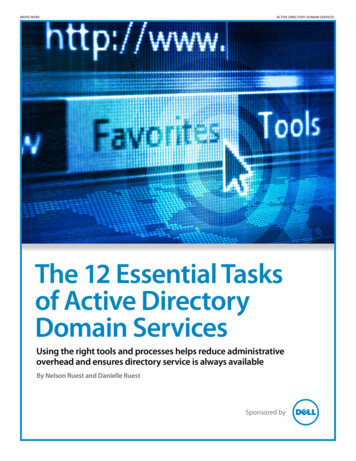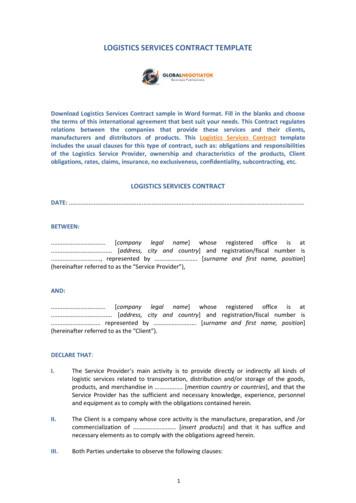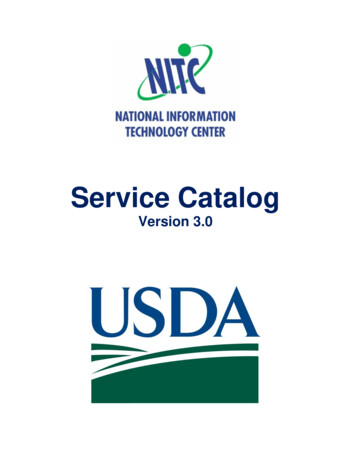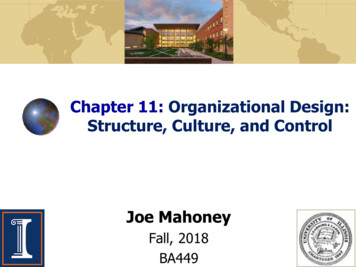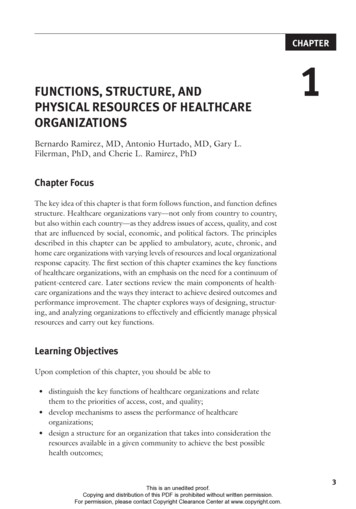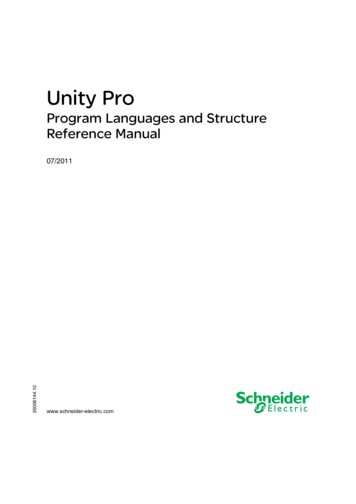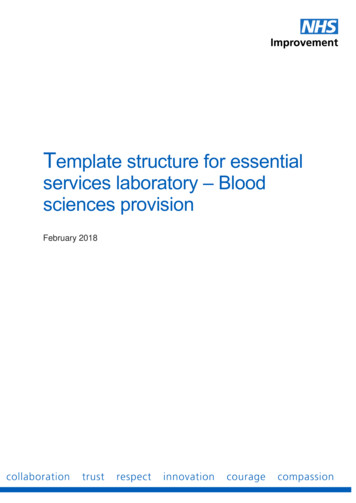
Transcription
Template structure for essentialservices laboratory – Bloodsciences provisionFebruary 2018
We support providers to give patientssafe, high quality, compassionate carewithin local health systems that arefinancially sustainable.
ContentsIntroduction . 2Definition of essential services laboratory . 2Purpose . 3Methodology . 3Disclaimer. 3Useful links . 4Operational functionality . 5Clinical governance . 5Laboratory information management system . 5Logistics . 5Quality . 6Health and safety . 6Training . 6Business continuity. 7Scope of testing . 8Transfusion. 10Required equipment. 11Required resources. 13Organisation structure . 13Shift duties. 13Roster patterns . 14Implementation . 201 Contents
IntroductionAbout 130 NHS trusts and foundation trusts provide their own pathology services,often using outdated operating models that need investment in premises, IT andequipment. This also exacerbates competition for increasingly scarce staff. TheCarter reports1 into pathology optimisation recommended the consolidation ofpathology laboratories to maximise existing capacity and savings from economiesof scale. This recommendation is endorsed by international and NHS evidence thatthe sustainable pathology services resulting from consolidation and modernisationincrease both quality of service for patients and efficiency.We are looking for an increase in the ambition behind and speed of consolidation ofpathology services across the NHS. The Carter reports1 propose consolidation byintroducing a ‘hub and spoke’ model whereby high volume, non-urgent work istransferred to a central laboratory to maximise benefits through economies of scale.Spoke laboratories, referred to as essential service laboratories (ESL), then providelow volume urgent testing close to the patient.Definition of essential services laboratoryAs mentioned above, in the ‘hub and spoke’ model of pathology optimisationthrough consolidation, each spoke is an ESL. These are also commonly referred toas ‘hot labs’, ‘spoke labs’, ‘STAT labs’ and ‘hospital labs’.An ESL provides a fit-for-purpose scope of pathology testing focused on timecritical, near-patient tests. Where there is no impact on safety or the quality ofpatient care, non-urgent testing should be centralised to the hub laboratory.ESLs’ work largely concerns the provision of urgent, near-patient blood sciencesthrough a mixture of point of care testing (POCT) and laboratory testing.1Report of the Review of NHS Pathology Services in England (DH 2006)Report of the Second Phase of the Review of NHS Pathology Services in England (DH 2008)Operational productivity and performance in English NHS acute hospitals: Unwarranted variations(DH 2016)2 Introduction
PurposeThis document informs laboratories that are consolidating their pathology servicesabout possible structures and service offerings for ESL blood sciences provision. Itoutlines the scope of blood sciences testing that these laboratories should consideroffering – including haematology, clinical biochemistry, coagulation science andblood transfusion – while factoring in the dynamic demand from urgent and acuteclinical specialities.We recognise that an ESL also needs to provide services related to urgentmicrobiology, histopathology and POCT – such as urgent cerebrospinal fluid (CSF)testing, frozen section analysis and blood gas analysis. Guidance on these serviceswill be issued in subsequent documents.We recommend that POCT is operated and controlled by the pathology laboratoryunder the clinical governance of a consolidated pathology network.We also provide an overview of the equipment required to perform this scope oftesting, and guidance on potential staffing structures for ESL blood sciencelaboratories, again factoring in different demand structures.MethodologyWe have compiled this guidance by drawing on a combination of laboratorymanagement experience and expertise, reviewing ISO:15189 laboratoryaccreditation standards and input from the Royal College of Pathologists (RCPath),The Institute of Biomedical Sciences and the Association of Independent PathologyProviders.DisclaimerWe provide general guidance only and each individual ESL and network shouldassess the model for delivering essential laboratory services to ensure testingscope, turnaround times, logistics, IT and quality systems are in accordance withISO:15189 and other industry guidelines such as those from the Medicines andHealthcare products Regulatory Agency (MHRA) and the National Institute forHealth and Care Excellence (NICE). The configurations, location and capacity ofhub services will also define the essential services delivered at a spoke site. Thistemplate structure may need to be adapted for local use.3 Introduction
Useful linksPlease also refer to the following: The Royal College of Pathologists www.rcpath.org/Institute of Biomedical Sciences www.ibms.org/United Kingdom Accreditation Service www.ukas.com/National Institute for Health and Care Excellence www.nice.org.uk/British Society for Haematology www.b-s-h.org.uk/Medicines and Healthcare products Regulatory s-and-healthcare-productsregulatory-agency4 Introduction
Operational functionalityClinical governanceESLs should fall under the clinical governance structure of the network, with thenetwork’s clinical governance policy making it clear who holds overall clinical andoperational responsibility for its ESLs.Laboratory information management systemAn ESL must use the same information management system as the hub laboratoryor be connected to it via a seamless integration engine with bidirectionalmessaging. This makes it easier to separate those tests within a request to becentralised from those to be performed locally. Operating on the same laboratoryinformation system allows seamless delivery of results to referrers, batch andreceipt of specimens, tracking of specimens, additional and follow-on testing, aswell as either an ESL or hub to request and perform recollect testing.LogisticsDue to the nature of centralising pathology specimens, a robust logistics systemshould be designed between ESLs and a hub laboratory. Transport between ESLand hub is required and this operation can be managed by either an in-house orcontracted-out courier service. Each ESL needs to decide where it locatesspecimen reception and data entry; there are several operational models for this,two of which are described below.Example specimen reception model 1Direct access specimens (cold work) are sent directly from the community setting tothe hub laboratory where a central specimen reception (CSR) department receiptsand books them in. All specimens collected on a site with an ESL (acute work) arereceipted and booked in onsite. Testing that falls outside the scope of the ESL isbatched and sent directly to the hub laboratory.This model maximises the economies of scale efficiency of a centralised specimenreception area, but compromises the tracking transparency of specimens.5 Operational functionality
Example specimen reception model 2Direct access tests within a defined geographical radius are sent to an ESL wherethey are receipted, booked, batched and transported to the hub laboratory. Allspecimens collected at the ESL (acute work) are receipted and booked in onsite.Testing that falls outside the scope of the ESL is batched and sent directly to thehub laboratory.This model requires more investment in resources at the ESL, but increases theability to track specimens and gives the hub laboratory more time to prepare for thedemand. For example, specialised testing can be prepared and batch testingplanned before the specimens arrive at the laboratory.QualityAn ESL should conform to ISO:15189 standards through a centrally run qualitymanagement system and to industry guidelines such as those from NICE andMHRA. The quality management system should involve an internal audit scheduleat the discipline and operational function level. The internal audit system should becontrolled centrally with quality leads at each ESL site. These leads can havescientific duties as well as their quality roles, provided they give sufficient time toensure ESL quality standards.Health and safetyAn ESL should conform to the same health and safety standards as the hublaboratory.TrainingWhere possible, all training management should be centralised to minimise thetraining burden on a single laboratory. An ESL should only be responsible for sitespecific training, resource this function appropriately and follow acceptedprofessional training programmes to ensure all aspects of training are delivered forthe right grade of individual. The regular rotation of staff from hub to spoke providestraining and experience of different working environments and can help developstaff.6 Operational functionality
Business continuityWith a hub-and-spoke model, consideration needs to be given to how an ESL cancontinue to provide the desired level of service if the hub is compromised – such asin the event of fire, IT and power failures or natural disasters. An element of sparecapacity and scope may need to be built into an ESL to handle central specimens ifrequired.7 Operational functionality
Scope of testingThe scope of testing performed at ESLs will depend on local geography, patientbase, logistics and CSR model. The testing covered should also consider guidancefrom professional bodies such as RCPath, IBMS, MHRA and NICE guidelines.Table 1 identifies a suggested scope of blood sciences testing. Aside from specificlocal requirements, we suggest that testing that falls outside the agreed scope ofthe ESL and direct access (cold work) is centralised to a hub laboratory. This scopedoes assume that a level of POCT is available throughout the operations of thehospital/laboratory.The scope of blood sciences testing should consider the full patient pathway, suchas keeping certain testing capability onsite if this allows for more efficient patientdischarge. What an ESL can cover should also consider agreed turnaround timetargets, whether or not retesting and additional testing will be possible within anappropriate timeline, and the robustness of the network’s logistics system.Table 1: Suggested scope of blood sciences testing for an mical profile*CRPMagnesiumLactateTherapeutic racetamol**Serum CSF, urineSerumSerumSerumSerumChemistry analyserChemistry analyserChemistry analyserChemistry analyserChemistry ry analyserChemistry analyserChemistry analyserChemistry analyserChemistry analyserChemistry analyserChemistry analyserPT(INR)APTTTTAnti-Xa lation analyserCoagulation analyserCoagulation analyserCoagulation analyserCoagulation analyser8 Scope of testing
HaematologyImmunohaematologyTestSpecimenMethodFBC (inc morphologyexamination)MalariaWhole bloodReticulocyte countWhole bloodHaematology analyserand microscopeMicroscope examination(special stain)Haematology analyserGroupPlasma/Red cellsAntibodiesPlasma/Red cellsCrossmatchPlasma/Red cellsAntibodyinvestigationsCord bloodPlasma/Red cellsRed cell phenotypingInvestigation oftransfusion reactionDAT (Coombes)Red cellsWhole bloodPlasma/Red cellsAnalyser, cards or tubesAnalyser, cards or tubesAnalyser, cards or tubesAnalyser, cards or tubesAnalyser, cards or tubesManual cardAnalyser, cards or tubesManual cardPlasma/red cellsRed cellsBlood bankingProvision to supply:MethodTrauma packsRed cellsPlateletsPlasmaBlood fridgeBlood fridgePlatelet rockerFreezer, thawing bath,blood fridgeBlood fridgeRed cells (irradiated,CMV–)Platelets (irradiated,CMV–)Blood products (IViG,albumin, etc)Platelet rockerBlood fridge* Biochemical profile: sodium, potassium, chloride, bicarbonate, urea, creatinine, urate, glucose,calcium (corrected), phosphate, bilirubin, total protein, albumin, AST, ALT, lipase, ALP, GGT,cholesterol, triglyceride, eGFR.**Toxicity screen: ethanol, paracetamol (extensive POCT toxicity screens can provide qualitativetoxicity information).Laboratory clinicians and managers may evaluate local clinical requirements and,depending on these, add testing to their scope such as serum and urine osmolality,Kleihauer screen for fetomaternal haemorrhage or intraoperative parathyroidhormone (PTH) for hyperparathyroid removal.9 Scope of testing
TransfusionTransfusion testing should follow existing guidelines from the British Society forHaematology (www.b-s-h.org.uk/) and nic issue and remote release should be used in a network with a robustlaboratory IT infrastructure.10 Scope of testing
Required equipmentTable 2 lists the equipment required to perform the scope of testing outlined above.We have intentionally not specified particular analysers as the most appropriate onewill depend on volume and site-specific requirements such as throughput, availablespace and agreed turnaround times.This list covers department-specific scientific equipment and not general items suchas reagent fridges, storage cupboards, etc. Due to the nature of urgent turnaroundresults in an ESL, the requirement for backup equipment should be assessed tomitigate the risk of analyser or equipment downtime or failure. This assessmentshould be made with consideration of the services provided by the hospital the ESLis serving and the business continuity plans across the network.Table 2: Outline of equipment for an logyCentrifugeCentrifugeHaematologyanalyserBlood reezerMicroscopePlatelet rockerImmunoassayanalyserThawing nalyserCard readerEquipment platforms should be standardised so that testing results arestandardised across the network, and the individual analysers should be fit for therequired volume to minimise overcapacity. As a laboratory moves from a full service11 Required equipment
laboratory to an ESL, existing equipment is likely to provide more capacity thanrequired. Depending on the volume through the ESL, pre and post-analysis roboticsmay be considered for specimen sorting, decapping and storage.12 Required equipment
Required resourcesLike any laboratory, an ESL requires a skill mix of pathologists, biomedicalscientists and medical laboratory assistants. Volume is the primary driver ofrequired staffing resources; other factors include complexity of work, level ofautomation and technology integration, arrival patterns, shift patterns,organisational structure, resource weighting and workforce split.Organisation structureManagement activities other than ESL site-specific management duties should becentralised. All policy and procedure development, quality systems, IT support,logistics management and scientific management should be centralised. Localoperational functions such as roster development, HR functions, interaction withlocal hospital, local logistics and local quality management should be performed byan onsite laboratory manager at the ESL. Depending on the size and volume of thelaboratory, this manager or supervisor should also perform scientific duties.Scientific management and supervisionAll scientific policies and procedures should be uniform across a network.Department or discipline managers should be located centrally and perform regularvisits to and internal audits at each ESL. However we highly recommend that seniorscientist representation is present in each discipline at an ESL.Overall clinical and operational management of an ESL can be supported remotelyby the hub, with supervision through regular site visits, management reviewmeetings and interaction with referring clinicians in the associated hospitals.Shift dutiesMedical laboratory assistants should be trained to perform duties across alldisciplines of an ESL. Multidisciplinary biomedical scientists are particularly usefulfor an ESL as they can multitask, allowing greater flexibility to achieve greaterefficiency. Multidisciplinary scientists also allow scientific duties to be concentrated,which reduces the overall laboratory resource requirement.13 Required resources
Roster patternsThe following shift pattern and resource weighting is an example for an ESLprocessing approximately 1,500 daily samples (Tables 3 and 4). Roster patternsneed to be considered alongside test request arrival patterns at the ESL.The suggested shift patterns assume that once a laboratory no longer does directaccess work, most specimens are received during a morning peak, with work tailingoff into the evening and only emergency work received throughout the night. Effortsshould be made to match capacity and demand, and any resource schedulingshould be the result of a laboratory process review.A robust shift roster should take into account annual leave and sickness rates andrecognise flexible working conditions.The roster patterns provided in this guide assume no multidisciplinary biomedicalscientists are present. Efficiency gains could be made by introducingmultidisciplinary scientists into an ESL. For example, many biomedical scientists inESLs are cross-trained in both haematology and blood transfusion. The use ofmultidisciplinary scientists represents an opportunity for further efficiencies to thismodel.14 Required resources
Table 3: Shift patterns for an example ESL Monday to :0021:0022:0023:00Haematology BMSBand 5-6 Band 7 Band 5-6 Band 5-61111111111111111111111111111111115 Required 0:0021:0022:00
1 Report of the Review of NHS Pathology Services in England (DH 2006) Report of the Second Phase of the Review of NHS Pathology Services in England . while factoring in the dynamic demand from urgent and acute . and the robustness of the network’s logistics system. Tabl


